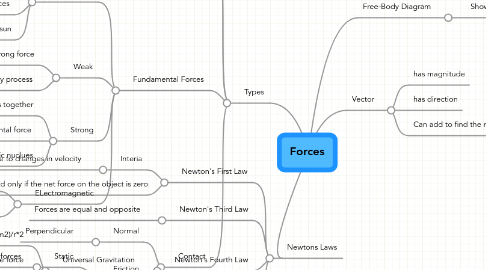
1. Types
1.1. Tension
1.2. Ideal Pulleys
1.2.1. has no mass and no friction
1.3. Fundamental Forces
1.3.1. Gravitational
1.3.1.1. Newton's Fourth Law
1.3.1.2. g=9.8N/kg
1.3.1.3. Weakness of the fundamental forces
1.3.1.4. Why planets orbit around the sun
1.3.2. Weak
1.3.2.1. Even shorter the Strong force
1.3.2.2. Radioactive decay process
1.3.3. Strong
1.3.3.1. Holds protons and neutrons together
1.3.3.2. Strongest Fundamental force
1.3.3.3. Negligible at distances much larger then the size of atomic nuclues
1.3.4. ELectromagnetic
1.3.4.1. Unlimited in range
1.3.4.2. Fundamental interaction that binds atoms together
1.4. Contact
1.4.1. Normal
1.4.1.1. Perpendicular
1.4.2. Friction
1.4.2.1. Static
1.4.2.1.1. proportional to the magnitude of the normal force acting between 2 forces
1.4.2.2. Kinetic
1.4.2.2.1. proportional to the normal force and the independent speed
2. Newtons Laws
2.1. Newton's First Law
2.1.1. Interia
2.1.1.1. reisitance to changes in velocity
2.1.2. An object's velocity doesn't change if and only if the net force on the object is zero
2.2. Newton's Third Law
2.2.1. Forces are equal and opposite
2.3. Newton's Fourth Law
2.3.1. Universal Gravitation
2.3.1.1. F=(Gm1m2)/r*2
2.3.1.2. attractive force
2.3.1.3. proportional to masses of the objects
2.4. Newton's Second Law
2.4.1. F=ma
2.4.2. Force vector = mass scalar time acceration vector
